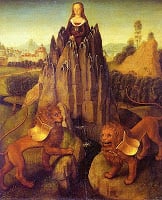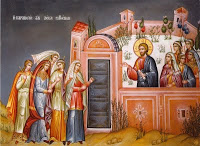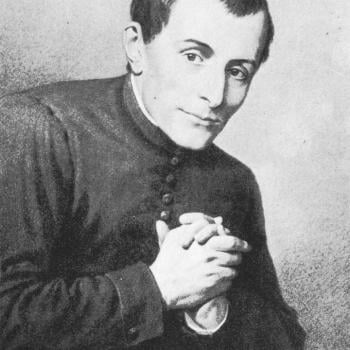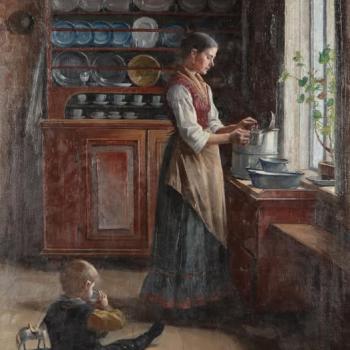Throughout most of Church history the study of scriptures was not undertaken using the historical critical method that is employed by most of the Biblical scholars today. Today most scholars seek to arrive at an understanding of what the author originally intended. However, in the ancient and medieval Church scripture was read for meaning at a basic level, looking for what the text seems to say on the surface, but than also read with the assumption that the text could be used to show meaning in a deeper allegorical way. This reading looked beyond the immediate intent of the parables and began to assign symbols to objects within the parables, or looked for ways to express theological truths using Jesus’ parables as a foundation or jump off point. In other words, they would create parables within the parables. This process is what scholars today call “allegorizing.” One way to look at this process is similar to improvisation done in jazz music. Just like a jazz musician riffs off a theme and creates new interpretations, allegory could be called theological riffing; theologians in the church would take the theme of the scripture they were looking at, and improvise using other truths in the traditions of the Church.
I recently read through Stephen L. Wailes’ Medieval Allegories of Jesus’ Parables (University of California Press, 1987). It was a fantastic resource toward understanding this history of interpretation. Wailes is not a theologian per-say; he instead self identifies with the field of medieval studies. This perspective is very valuable in this undertaking since much of the allegorizing that has been done in the church finds its home squarely within the culture and practice of medieval Europe. This book also gives some excellent examples of how parables have been used in Allegory over the years. Let me give one example:
The early christian commentator, Origen, takes the account of the 10 Virgins found in Matthew 25:1-13 and explains it as such:
- The bridegroom is Christ
- The bride is either Christ’s human nature or the Church
- The delay is the time between the crucifixion and the second coming
- The night signifies the unexpected nature of the return
- The drowsiness shows the sickness of men before the judgment
- The clamor upon the bridegroom’s return is the trumpets call on the last day
- The begging of the foolish virgins for oil shows the impossibility of borrowing merit that is not held inwardly
This analysis of the parable demonstrates how Allegorization worked fairly well. It played alongside the original theme to draw out additional opportunities for teaching. Many people today would agree with calling the bridegroom Christ, however very few would make the connection that the bride was Jesus’ human nature, or that the oil represents relative merits. The allegory functions as a theological remix.
The book is filled with examples like this. This is just one example among the forty-one parables Wailes analyzes, almost all of which cite more than one allegory is used to interpret each parable. As I read through Wailes’ book a few historical themes began to emerge. It seems the remixing of these parables followed certain rules and guidelines. I would like to call these The Past Protocols for Peripheral Parabolic Presentation (The 5P rules for remix). I have listed the rules I was able to recognize, although I am sure there are more.
- Allegories must fit the main theme of the scriptures as a whole. You can’t create an allegory and insert into it bad theology. At the heart of any orthodox allegorization is orthodox theological understanding. Augustine even went so far as to suggest that if a story in scripture seems to go against the central premise of scripture (it teaches nothing but charity and condemns nothing but cupidity) it should be explained allegorically rather than literally. (Wailes, 9)
- Allegories can be used to help people understand more than one thing in the same parable. As we saw above sometimes the bride is used in the parable of the “ten virgins” to mean two different things by the same commentator. This parable has also been used to explain the history of religion showing a movement from polytheism to monotheism, as well as an allegory of faith’s relationship to works. A writer may like one allegory in one instance, but use a different allegory in another instance (Wailes, 41).
- Allegory is a tool for the Mystical life. Allegorization is not primarily used for developing a systematic theology, or for offering an apologetic for a belief, but rather they are seen as valuable doors through which a christian can hope to see God. The mystic Martin of Leon even went so far as to call them “vital” (Wailes, 69).
- Alleogry is a realm in which people participate with God in creation. The scripture is seen as something of divine origin. People did not offer allegories believing they were doing basic exegesis, but understood that they were taking a divine word and creating new variations and perspectives using it. Sometimes people would look at history though a parable, sometimes people would look at the spiritual state of man. It is clear that in many cases the allegories were seen as crafting new variations on divine material (Wailes, 95).
- The Scripture being used can be foundation upon which the allegory is built, but it can also be simply a jumping off point. The example given of Origen’s allegorization of the the virgins would be an example of one in which the parable remains the foundation of the allegory. There are other examples, though, where people take an image a run with it much farther than the narrative of the piece of scripture . For example Augustine takes the numbers 30, 60, and 100 in the parable of the sower and uses them to make a commentary on stages of life. Thirty represents the time of life of early marriage and struggles with lust, sixty represents the time in which you are no longer required to serve in the military, and one hundred refers to the stage at which we no longer fear death (Wailes, 100).
- Jesus Christ is the central hermeneutic through which to read the scriptures. There are times when it is difficult to square a story or image in scripture with an interpretation. In these times writers would look at Christ as the central way to understand the issue in the scripture (Wailes, 150).
- No reading of a Parable can assume one for one correspondence. Even those who did allegorizing recognized that a parable is simply a likeness of thing and not the thing itself. In the words of Nicholas of Lyra, “a parable does not run on four feet, for if it agreed in every detail it would not be a matter of likeness but identity” (Wailes, 247).
Even though Wailes is concerned with an allegorization method that happened hundreds and even thousands of years ago, does not mean the practice of allegorizing is in any way irrelevant to today’s world. With the advent of deconstructionalism
and multiplicity of “new hermeneutics” that highlight the texts of the Bible from different subjective angles, there is a new breed of allegorization going on with the Bible today. The underlying hermetic of many of these new allegories is much more dubious than the central hermenutic of Christ that we see in the guidelines above. People are reading themselves into the text rather than Jesus. An allegory is a way to assert a worldview through a mystical door. When we read allegories today, we must not only ask what they are trying to say, but also what they are assuming. It is in finding that assumption that we can see where the door is trying to lead us.


.jpg)













